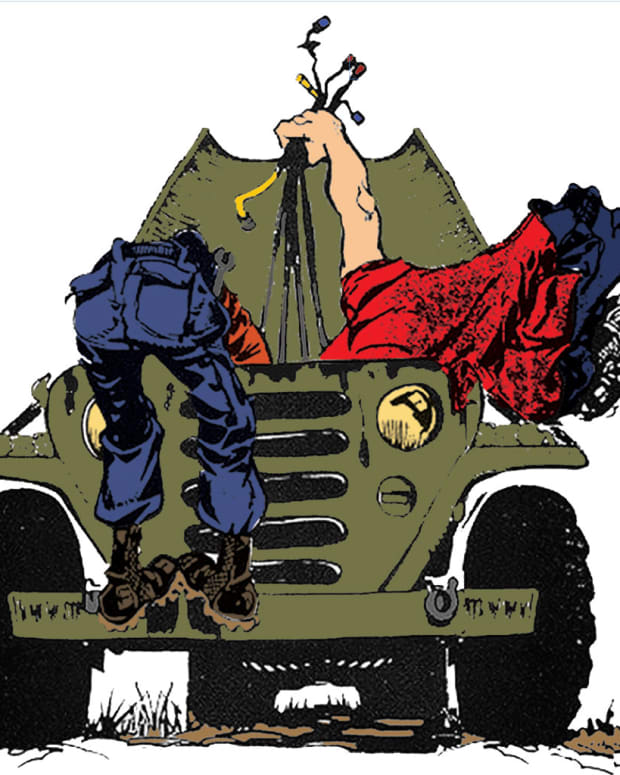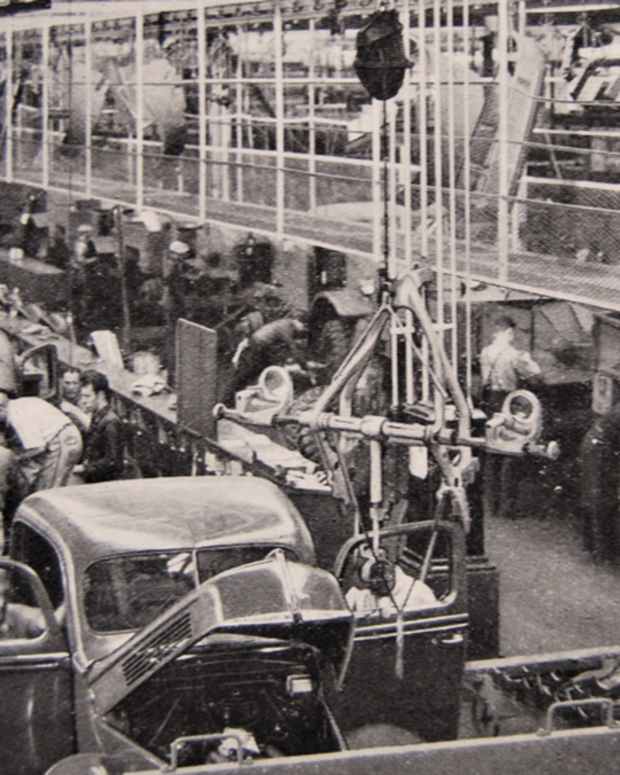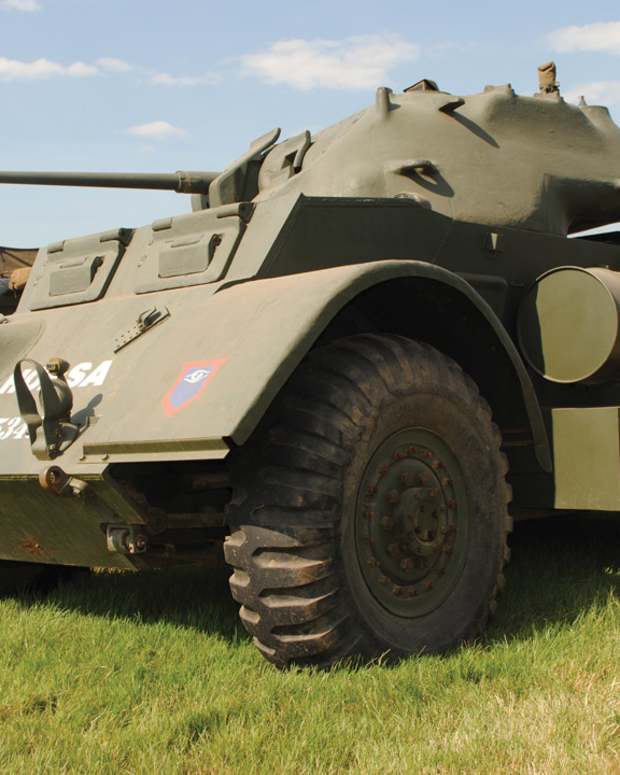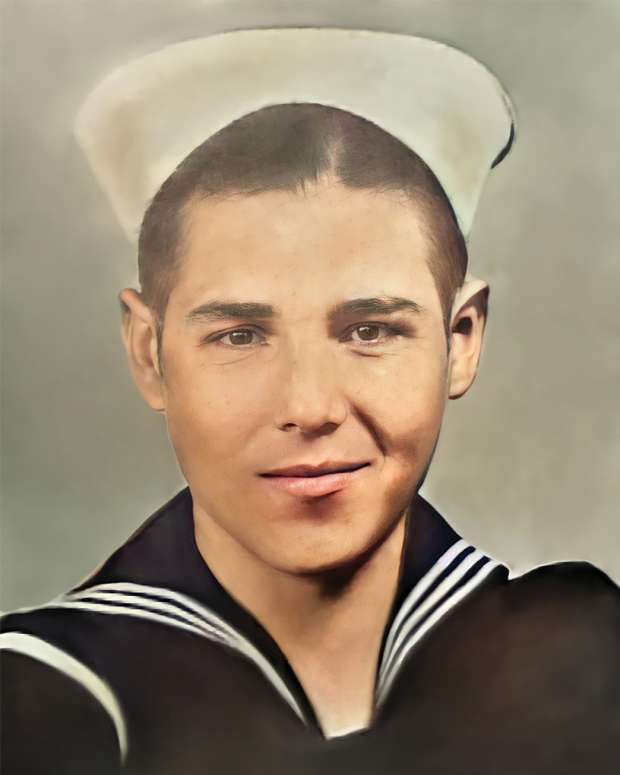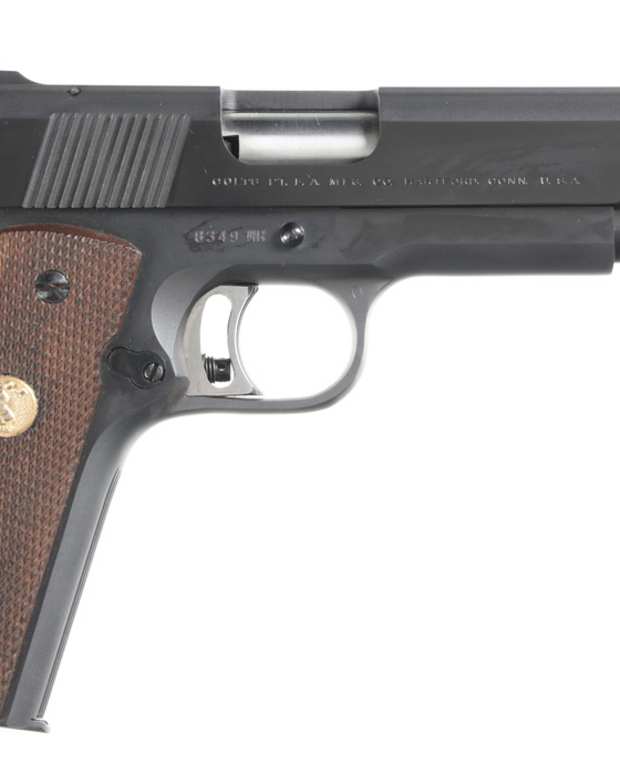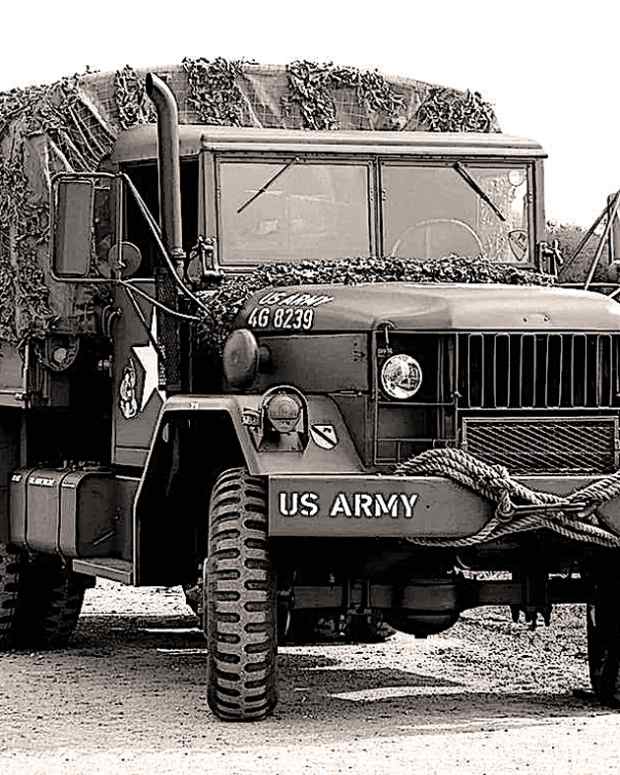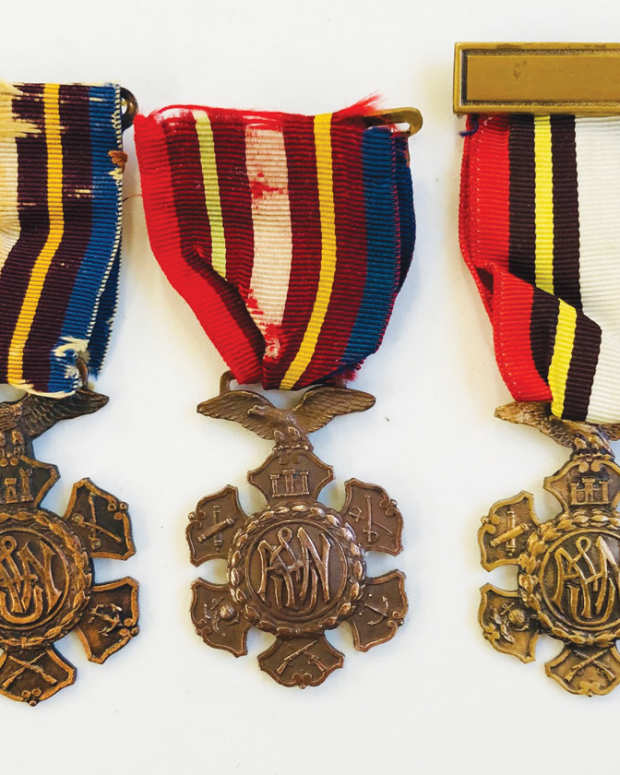The “Cadillac” of Deuces
The GMC M211
by Steve Turchet

The G-749 family of vehicles—including the M211 and its 6-wheel variant, the M135—were painstakingly designed and engineered by General Motors in the hope that these trucks would be a permanent replacement for the CCKWs of WWII. General Motors pointed out that the vehicle’s similarity to the CCKW would make the M211 easily maintainable and repairable for motor pool personnel who were already trained on the G-508 (CCKW) family of vehicles. Further simplifying maintenance, the M211’s transmission operated on engine oil (OE) rather than automatic transmission fluid (ATF).
I was seventeen when I first saw an M211 6x6 cargo truck. I was working at a lake and recreation area close to Camp Roberts in Central California, when I saw several M211s in a convoy out on a country road. I was driving my M38 at the time, which was still olive drab with faded white stars. Thisseemed to amuse the young soldiers, who grinned, waved, and flashed peace signs as we passed in opposite directions. Many were only months older than me, and I’ve often wondered over the years what lay ahead for them with the Vietnam War going on.
I saw many more convoys that summer. Besides M211s, there were M151s and M715s, and of course M37s. The M211s were a surprise to me because I had thought Army 2-1/2-ton trucks were M35 “Eager Beavers” like the Monogram model I’d built as a kid. Regardless, I thought the M211s looked kind of cool.
The M211s were also some of the very few vehicles, civilian or military, that my M38 was capable of passing. I would come upon a line of these trucks toiling up a grade, and for a while, I’d be part their convoy, passing the deuces one-by-one on a winding two-lane road. Sometimes, while trailing a truck and waiting for clearance to pass, I’d have short conversations with the soldiers in back, shouted above the roar of engines and the churning whine of the deuce’s ten tires. The topics were typically teenage—hometowns, cars, music, girls, and what was there to do around here?—though one soldier called as I passed his truck, that he wished he was driving my jeep! Since most of those young men had been drafted, I think I understood his meaning.
The soldiers often came to the lake to go swimming and party at night on the beach. One group, all teens, always arrived in an M211, and once they’d stripped down to their issue swim trunks they looked like high-schoolers wearing dog tags. They invited me to their parties, and I like to remember those hot summer nights with the lapping of waves on the shoreline and the crinkly pop of beer can tabs... which came off the cans in those days. I also recall the looming shape of the M211 parked on the sand and dimly seen in the moonlight.
Just as I often wonder what the future held for those teenage soldiers, I also think back to that summer in regard to what lay ahead for me. Little did I know,that about a year later, in what some might call déjà vu, I would find myself in a similar scene on a long hot night in a far-away land—though the deuce in the moonlight was an M35.
But, back to that happier summer. Just like my fondness for jeeps, I also loved big trucks, so I was naturally interested in the M211, although, at the time, I thought Reo M35s looked cooler, the M211 was there to inspect. I was also intrigued that this big ten-wheeled, olive drab piece of genuine U.S. Army property was loaned to my dog-tagged teenage friends like borrowing the car from dad. Or in this case, “Uncle.”
To say that I was all over that truck would be an understatement. I found it had many cool features: The storage compartment under the cab, the nifty swing-out spare wheel mount, the windshield that could be folded down (though the truck was always equipped with full canvas) the windshield glasses that opened, the vertical exhaust pipe, and even the headlamp guards in the grille that were hinged to swing out for bulb replacement.
I also found that my M38 had many things in common with the M211, such as the blackout lighting system, and also the dashboard instruments. There were many other features on the M211 that seemed thoughtfully designed: the twin supports that clicked into place when the hood was raised, and the no-nonsense starter lever on the transmission shift pedestal. I also discovered that the entire power unit—engine, radiator, transmission—was meant to be easily removable, though this was a feature built into many M-series vehicles. The engine itself was cool, because except for components like the 24-volt waterproof ignition (which my M38 still had) and the air compressor, it was the same engine I had seen in many GMC pickups and trucks. About the only thing I didn’t like was the M211’s automatic transmission.

The M211 and variants could ford about thirtyinches of water unprepared, or could be fitted withdeep water fording kits that allowed them to run under nearly seven feet of water. The vehicles could be equipped with a wide array of accessories and kits, such as heaters, radio equipment, gun mounts, shelters, and extreme cold weather gear, and also with front-mounted 10,000 lb. capacity self-recovery winches, which were usually manufactured by Gar-Wood.
THE AUTOMATIC TRANSMISSION
Unless you’re old enough to remember when (and why) most U.S. radio dials had little triangles at 6.40 and 12.40 AM, you might not know that mostteens back in those days thought automatic transmissions were for grandmother’s cars, and real American males drove sticks—preferably four-on-the-floor. Therefore, it seemed almost sacrilegious that a big, mighty Army truck would have a “slush-box” transmission. The truck’s young driver shared these feelings; and some military vehicle experts have theorized that the automatic transmission was one of several reasons why the G-749 family of vehicles, which included the M211,was never fully accepted by GI’s, and were, if not actually abused, at least often pushed beyond their limits.
This cavalier treatment probably served to accentuate several weak points, quirks and flaws in what was an otherwise a well-designed, well-built, and rugged military vehicle. Several vets who served in the U.S. Armed Forces in the 1950s have told me that many G.I.s felt that M211s were “old ladies’ trucks.” One former gunny sergeant remarked that the M211 was a good truck for WACs to use when going on picnics. This is interesting in light of the fact that a well-tuned M211 running empty could accelerate from 0 to 55 mph faster than many American cars of that period. This isn’t bad when one considers that there was only about 130 horsepower to move about 14,000 pounds of truck.
I had learned to double-clutch the crash-box four-speed transmission in my dad’s 1947 Reo (civilian) two-ton truck by the age of eight, so I had the same kind of negative feelings when checking out my first M211. Another thing I wasn’t happy about was the lack of two shift levers on the floor—as of course my M38 had—to control the all-wheel drive. The driver told me that engaging the front axle was also an automatic feature. At that time, long before toasters had on-board computers, this seemed like something from Star Trek.
DRIVING THE M211
By the night of our second beach-party the M211’s driver and I had become good friends; and I was stoked when he offered to let me drive the big beast. (I’m sure “Uncle” would have been very upset.) The road to the beach snaked down through grassy, rolling foothills that are common in that part of California; and I quickly learned why many G.I.s weren’t happy with M211s. The driver had given me a few instructions down on the flats by the beach, and except for the vehicle’s size, it wasn’t any harder to drive than my grandmother’s automatic-equipped 1963 Ford Falcon. The driver’s position was comfortable, the steering wheel was angled just right, and the view over the short, rounded hood was actually better than from my grandmother’s car, as well as enhanced by being six feet above the ground.
It seems funny now to remember that experience; two average American teens in cutoff jeans and swim trunks cruising along through a hot summer night in a rumbling weapon of war. The windows and windshields were open, we were comfortably full of burgers and beer, and our minds were on anything but war. All the truck needed was an AM radio playing the Rolling Stones…or better still an eight track deck. Despite the M211’s slush-box, I was really starting to like the truck.
However, as we started up into the hills, a few the M211’s quirks became apparent. Down on the flats the transmission had shifted flawlessly, if rather firmly, through all its four gears... though, being used to keeping the RPMs low in old trucks, I thought the engine was turning too fast before the transmission up-shifted. The truck also had a tendency to blast through first and second gears then slam into fourth on level ground, skipping third gear entirely. This “slam” is very much intensified in a large heavy vehicle; and a mechanically-minded person begins to wonder how many such slams the running gear can take.
Then, climbing into the hills, it seemed as if the transmission couldn’t make up its mind what gear it wanted. It would lug the engine way down until my left foot and right hand were going for a clutch pedal and shift lever that weren’t there, then it would suddenly down-shift with another violent slam. Then, just when it seemed that the engine was comfortable, the transmission would spoil the party by up-shifting and lugging the engine again. At last, when it seemed that the engine was going to give up and die, the transmission finally slammed back to a low gear. This performance was repeated constantly every time we climbed a hill.

Restored XM 211 with winch and ring mount. Most people familiar with the M211 and G-749 family know that there were many “XM” versions. “X” generally stands for Experimental when it comes to U.S. Military vehicles—and it seems the G-749 family had quite a few experimental models and variants!
I kept thinking of the shock and strain on the drive shafts, axles and universal joints caused by the jerky, erratic, and often needless shifting of the automatic. One other lesson I learned that night was never to use High Range reverse. The driver offered the highly technical explanation that it “screws-up the tranny.”
Which it does, and for reasons we’ll get to later.
THE “CADILLAC OF DEUCES”
The scents of canvas and hot engine oil often take me back to that night, which I guess you could call my introduction to deuces. No doubt the Camp Roberts Motor Pool sergeant would have produced a litter of kitties had he ever found out, but I think “Uncle” eventually got a better driver because of those unofficial lessons. Even though in the relatively near future I would find myself at the wheel of many other deuces, these would all be M35s. It seems funny that I had thought the Eager Beaver to be a better deuce, but I quickly found that, compared to the LDS Multifuel-powered M35s of the Vietnam era, the M211 was the Cadillac of deuces in many ways.
This might seem more logical if one considers that, except for the two-speed (High-Low range) reduction unit on the rear, and a few other military features, such as an additional oil pump that allowed the truck to be pull or push started, the M2ll’s transmission was basically the same as those found in many 1940s and early 1950s Cadillac cars.
It should probably be said that, regardless of many persistent myths, these transmissions were General Motors products—302M (early production) and 303M (late production)—built by G.M.’s Hydramatic Division, and not Allisons. The Allison story may have started simply because some folks found it hard to believe that a “big Army truck” would be fitted a “car” automatic.

One of the military’s specifications for M-series vehicles was an easily replaceable power unit, usually including radiator and transmission. Note the two-speed unit on the rear of what was basically a Cadillac automatic transmission on the GMC 302 engine.
However, by the late 1960s and during the hottest years of the Vietnam War, the most common tactical deuce-and-a-halfs were LDS (Continental) multifuel-powered M35s. While there were still Reo gas-powered M35s in service, these, like the M211, were mostly regulated to stateside, base duty, and/or used for training purposes...and beach parties. I drove several gas-powered Reos, and even though the Reo 331 engine is much more rugged than the GMC 302—being a sleeved engine and having seven main bearings versus the GMC’s four—the M35s of the period seemed primitive compared to the M211.
Of course, primitive is not always a bad thing, and even though the M211 and its G-749 family were more sophisticated in many ways than the M35 and its G-742 family, some of these refinements provided more chances for things to go wrong. Such failures were not always big or serious, but were nevertheless inconvenient or annoying. For example, if not kept clean and well oiled, the M2ll’s click-into-place hood supports would jam. This often turned simply closing the hood into a two-person job. This was never a problem on M35s because they only had a primitive brace to hold the hood up. Although I’ve heard that late production M211s had only a single front-mounted hood support, our beach party truck had both, as did the two M211s I would buy in the future.
ORIGINS OF THE M211
There are many stories of how and why the M211 originated. Some folks say that the G-749 family of GMC trucks were meant to be transition vehicles between the rugged and dependable GMC CCKW 2-1/2-ton trucks of WWII and the ubiquitous G-742 family of “Reo” trucks, of which the M35 is the most common. However, this doesn’t appear to be true, especially if one considers that the M35 itself—like many early M-series vehicles—were only supposed to be transitory until something better came along. Instead, most MV experts seem to agree that the M211 and its G-749 family were painstakingly designed and engineered because General Motors hoped these trucks would be a permanent replacement for their faithful CCKWs. In fact, if one compares an early Reo M35 side-by-side with a GMC M211, it’s the Reo that tends to look more like a truck that, although well designed, was simply built to do a job until something better could be found.
Again, it might not be going too far to use the Cadillac comparison, meaning that just about everything on an M211 looks as if it was specifically designed for the truck (which is mostly true). On the other hand, the M35 seems more like what used to be called an “assembled truck,” like many construction, mining, and quarry vehicles.

Although many GIs didn’t like the M211’s automatic transmission, automatic transmissions had proven themselves superior to manuals in many off-road situations, and a kit was developed to install M211 transmissions in Reo M35 trucks, though apparently this wasn’t done on any major scale. On the other hand, there was apparently little research done on fitting M211s with manual transmissions.
This is not meant to disparage the M35: and the proof of the M35’s ruggedness and longevity should be obvious, because as a series it still serves today. This shows that being a little primitive never hurts. Inversely, it might be said that many of the M211’s refinements and features may have been too advanced for their time. Just like many American males’ attitudes towards automatic transmissions in the 1950s, perhaps the U.S. Military just wasn’t ready for a Cadillac deuce?
On the other hand, the concept of a large tactical vehicle with an automatic transmission was not a space-age surprise. In fact, the Hydramatic transmission had already been used during WW II in the M24 Chaffee light tank as well as several other fighting vehicles. This transmission had also been tested in CCKWs in the late 1940s. In addition, the advantages of an automatic transmission—such as simplified driver training, and superior performance over a manual transmission in many off-road situations—had been discussed in a Report of the Wheeled Vehicle Policy Panel in May of 1951.
My own research seems to indicate that the G-749 family of vehicles originated in what was basically a competition among Studebaker Corporation, Reo Motor Trucks, and General Motors in the late 1940s to design a new 2&1/2 ton 6X6 to replace U.S. Military’s aging fleet of WWII deuce-and-a-halfs...which by then were mostly CCKWs and their many variants. It appears that G.M. wanted to hold on to the deuce market and not only put a lot of research, development, and its own money into the M211, but also designed the truck to use many of the same components as the CCKW. Therefore, it might be said that the M211 was a new and improved CCKW in much the same way that the M37 was a new and improved WW II WC Dodge. This should become apparent if one examines a “banjo-axle” CCKW alongside an M211.
The M211’s 302 cid gasoline engine was basically just a more powerful version of the durable 270 cid engine that had soldiered through WW II in thousands of CCKWs and DUKWs.
General Motors also pointed out that this similarity to the CCKW would make the M211 easily maintainable and repairable to motor pool personnel who were already trained on the G-508 (CCKW) family of vehicles. To further simplify maintenance, the M211’s transmission was built to operate with engine oil (OE) rather than automatic transmission fluid (ATF).
The latter point is something that current or potential M211 owners should be aware of. Although many M211s and their variants were later converted to use ATF, this usually involved installing new seals; and there were two types of rebuild kits, one meant for engine oil, the other for ATF. While there are many differing opinions in the HMV world about what can and can’t (or shouldn’t) be done in regard to M211 transmissions, one consistent warning is to never mix engine oil and ATF.
On the other hand, and speaking as someone who owned two M211s and used them for actual work, I never encountered any problems switching from engine oil to ATF. It’s been my experience that seals meant for engine oil will work fine with ATF. However, it’s also been my experience that seals meant for ATF may deteriorate if subjected to engine oil. One often hears warnings that it’s “impossible” to thoroughly flush an M211 transmission of engine oil without taking it completely apart: however, I simply warmed up my transmission by driving a few miles, drained the OE, filled it with AFT, warmed that up with another drive, then drained and refilled the transmission with ATF again. I put about 10,000 miles on that truck, many of those in heavy off-road use, and never had a problem—even though I did change the ATF several more times.
Still, like many of my experiences with HMVs, I’m not recommending that anyone else do this. I’m merely saying what I did. Bottom line, it’s your vehicle as well as your time and money that you should consider when doing any experiments.
Probably the best folks to answer these kinds of questions would be Memphis Equipment Company. Not only do they have decades of experience with these transmissions, but they also offer a special shift kit that eliminates many of the problems and quirks common to the M211. I also recommend Army Technical Manual TM 9-8025 -2 (Transmission Manual), available from Portrayal Press.
In any event, and even though the U.S. Military was trying to standardize and simplify their tactical vehicle fleet during those times—which might be described as the Korean War era—it found itself with not one, but two new deuces, the GMC M211 and the Reo M35, plus all the many variants of each. Also keep in mind that there were still many CCKWs in service, as well as International Harvester M-5-6 deuces in use by the Marine Corps. Another thing to consider, and which may have upset those in the military who were trying to standardize, is that there were also three different types of jeeps in service—the WWII models of Ford GPWs and Willys MBs, the M38, and the M38A1. To further complicate matters, the M151 MUTT (Military Utility Tactical Truck) was under development by the Ford Motor Company.
WHICH IS THE BETTER TRUCK?
It might be said that the GMC M211 and Reo M35 were tossed in the ring together, and let the better truck win. In one corner was the M211 with all its refinements, new features, and rather sophisticated engineering. In the opposite corner was the M35 with an almost brutish simplicity. The M211 had a sculptured look in front sheet-metal, while the M35 might have been carved from a block of iron.
This is not an article about which deuce of any make, model, or vintage is “better” than another. Aside from the fact that such comparisons are often meaningless in the HMV hobby where people usually choose vehicles because they like them, I’ve learned over the years that a few folks can’t seem to grasp the concept of a pro and con article. If they agree with the pros then it’s all good, if they disagree with the cons then the entire article “sucks rats.”
Anyhow, back to the smack-down: the Reo M35 had a five-speed manual transmission and a mechanically superior as well as slightly more powerful engine. Both trucks featured air-boosted hydraulic brake systems, 24-volt waterproof ignition and electrical systems, and a Sprag-type clutch in the front of their transfer cases that automatically engaged the front axle whenever the rear wheels started to slip... in other words, began turning faster than the front wheels. While both trucks had a high and low range for all-wheel-drive, the M35 had a two-speed transfer case while the M211 had a two-speed unit on the rear of its transmission and a single speed transfer case. This gave the M35 ten possible forward speeds compared to the M211s eight, though the M211’s smooth flow of power through the torque converter (dubbed a “Torus” by General Motors) gave it an advantage in boggy situations.
The M35 had just one rear drive shaft output from its transfer case, and its two rear Rockwell axles were connected in tandem. The M211 used the same dual rear drive shaft system as the CCKW and DUKW. This featured a separate drive shaft output from the transfer case for each rear “banjo-type” GM axle. As is common to virtually all U.S. military deuces, neither truck had an inter-axle differential, so the two rear axles would fight each other during tight turns, and especially if their tires were not evenly matched in size. This affects fuel mileage and increases tire wear, but seems to have been accepted since the days of the CCKW.
Both trucks and most of their variants could ford about thirty inches of water unprepared, or could be fitted with deep water fording kits that allowed them to run under nearly seven feet of water. Likewise, both trucks could be fitted with a wide array of accessories and kits, such as heaters, radio equipment, gun mounts, shelters, and extreme cold weather gear.
Both trucks could also be fitted with front-mounted 10,000 lb. capacity self-recovery winches. In both cases, the winches were usually manufactured by Gar-Wood, and were virtually identical except for their drive systems. The M35’s winch was driven from a PTO on the transmission, while the M211’s PTO was on the transfer case. Both trucks had manual parking brakes, though some M211’s had an additional electrically-applied parking brake of the Mico type. Yet another “Cadillac feature.”
In keeping with its more primitive concept, the M35 used a basic leaf spring suspension system similar to most three-axle civilian trucks of the period. On the other hand, and though also using leaf springs, the M21l’s suspension featured torque rods on the axles to prevent axle windup. This system, teamed with the automatic transmission, gave it arguably better performance when slogging through deep mud because it tended to avoid the spinning of wheels that often occurs with a manual transmission and clutch.
However, refinement and sophistication in a vehicle usually comes at a price; if not in dollars, then in complexity. While the M211 was designed for easy service and maintenance in many ways—such as the swing-out headlamp guards—it also had many more parts and components than the M35. For example, there were twelve wheel cylinders in the brake system. In short, while the M211 was more highly engineered than the M35, there were also many more things to wear out, break, leak, or go wrong... even if one doesn’t consider its automatic transmission.
Comparative basic specifications are as follows...
Both trucks and their variants were fielded during the early 1950s, not only to the Korean Conflict, but also to Europe to fight the Cold War. Disregarding the fact that many G.I.s just didn’t like the automatic transmission, problems for the M211 began to surface, and many were indeed the result of the transmission.
For example, unlike most of today’s automatics in which the transmission fluid is cooled by being circulated through an oil cooler usually located in the vehicle’s radiator, or mounted as a separate unit in front of the radiator, the M2ll’s transmission was chilled by the engine coolant. Though certainly not the fault of the transmission, but rather due to human error—i.e. not installing antifreeze—many M211 transmissions froze and cracked in both the Korean and European winters. Another weak point in the transmission—as mentioned in my beach party tale—was that High-Range reverse overloaded the rear clutch cone and often caused it to fail. For some reason this fault was never corrected, so it became SOP (standard operating procedure) never to use High Range reverse.
Unfortunately, many later civilian owners of these vehicles, as well as some National Guard and Army Reserve personnel, were not aware of this flaw. This resulted in thetransmission getting yet another bad rap.
However, the M211 and its variants were adopted by the Canadian Armed Forces and became their standard deuce for over thirty years. Interestingly, while several M35s were test-fitted with the M211’s automatic transmission and a kit was even developed to make the conversion, no research was apparently done to fit the M211 with a manual transmission.
THE M211 FAMILY
Most people who are familiar with the M211 and G-749 family know that there were many “XM” versions, such as XM211 and XM220. “X” generally stands for Experimental when it comes to U.S. Military vehicles; and it seems the G-749 family had quite a few experimental models and variants.

An M211 or one of its many variants would be an excellent deuce for an HMV enthusiast, as long as one is prepared to live with and care for its special needs in regard to the automatic transmission. The M211 and the G-749 family are unique, interesting, and very historical trucks. Parts availability is very good in the HMV world, and many engine and brake system components can still be found on the shelves of well-stocked truck parts suppliers. While there is admittedly more to go wrong—or at least more to service and maintain—on an M211 than on an early model M35, one will probably find that an M211 is more comfortable to drive and perhaps a bit more user-friendly.
While hundreds of M211s and variants were shipped overseas to various theaters during the Korean and early Cold War eras, most were soon shipped home again to serve in non-tactical, general transportation, and training roles. Production of the M211 and the G-749 family of vehicles ended in 1957, though the trucks themselves remained in active service into the mid-1970s, with many going to Army Reserve and National Guard units. Many others were surplused off to forestry and fire departments.
Many of these trucks also found their way into HMV collector and hobbyist’s hands, and no doubt received a big boost in popularly when an M135 six-wheel variant appeared in the first Rambo movie in the early 1980s. I owned an M211 at the time, and grew just as tired of hearing it called “a Rambo truck” as many Saint Bernard owners must have grown weary of having their gentle pets called “Cujo” after that infamous film.
As mentioned earlier, this isn’t an article about the “best” deuce for an HMV hobbyist to buy. As with any military vehicle, from a WWII Willys jeep to a current-production A.M. General HMMWV, one should always choose a vehicle because they like it. There are some in the hobby who seem to feel that the only deuce worth owning is a newer model diesel-powered M35 type. On the other hand, there are many who love the vintage looks of the WWII CCKW, the I.H.C. M-5-6, or the Studebaker US-6. In some ways this seems to leave the M211 out in the cold. However, the M211 and its G-749 family have just as much a place in history as any other military vehicle. After all, and despite their various flaws and quirks, they soldiered through the Korean and Cold War eras, and also served through Vietnam. Even if most of their roles weren’t tactical, more than a few M211s did see actual combat.
An M211 or one of its many variants would be an excellent deuce for an HMV enthusiast, as long as one is prepared to live with and care for its special needs in regard to the automatic transmission. As a personal deuce used mostly for recreation (or beach parties) and occasional hauling, or as a complete restoration project, the M211 and the G-749 family are unique, interesting, and very historical trucks. Parts availability is very good in the MV world, and many engine and brake system components can still be found on the shelves of well-stocked truck parts suppliers. While there is admittedly more to go wrong—or at least more to service and maintain—on an M211 than on an early model M35, one will probably find that an M211 is more comfortable to drive and perhaps a bit more user-friendly. While the M211 doesn’t have “Cadillac cup-holders,” it does have those cool swing-out headlamp guards.







